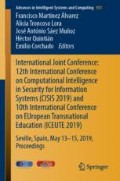Abstract
This work proposes a LabVIEW framework suitable for simulating and on-the-fly testing a hardware implementation of the Arrow lightweight pseudorandom generator. Its aim is twofold. The first objective is to provide a framework to simulate the pseudorandom generator behavior in a personal computer, allowing to modify dynamically the configuration parameters of the generator. Moreover, to visualize the randomness of the output sequences useful techniques like the chaos game and return maps are used. The second objective is to generate an architecture implementing the Arrow algorithm which can be downloaded into a real Complex Programmable Logic Device or a Field-Programmable Gate Array. Plots are shown which demonstrate the usefulness of the proposed framework.
Access this chapter
Tax calculation will be finalised at checkout
Purchases are for personal use only
References
Minoli, D., Sohraby, K., Occhiogrosso, B., Kouns, J.: Security considerations for IoT support of e-Health applications. In: Hassan, Q.F., ur Rehman Khan, A., Madani, S.A. (eds.) Internet of Things. Challenges, Advances, and Applications, pp. 321–346. Chapman and Hall/CRC (2018). Chap. 16
Sagahyroon, A., Aburukba, R., Aloul, F.: The Internet of Things and e-Health: remote patients monitoring. In: Hassan, Q.F., ur Rehman Khan, A., Madani, S.A. (eds.) Internet of Things. Challenges, Advances, and Applications, pp. 303–321. Chapman and Hall/CRC (2018). Chap. 15
Sfar, A.R., Natalizio, E., Challal, Y., Chtourou, Z.: A roadmap for security challenges in the Internet of Things. Digit. Commun. Netw. 4, 118–137 (2018)
Grammatikis, P.I.R., Sarigiannidis, P.G., Moscholios, I.D.: Securing the Internet of Things: challenges, threats and solutions. Internet Things J. 5, 41–70 (2019)
Misra, S., Maheswaran, M., Hashmi, S.: Security Challenges and Approaches in Internet of Things. Springer (2017)
Li, S., Xu, L.D.: Securing the Internet of Things, 1st edn. Syngress-Elsevier, Cambridge (2017)
Biryukov, A., Perrin, L.: State of the art in lightweight symmetric cryptography. IACR Cryptology ePrint Archive, p. 511 (2017)
ENISA: Good practices for security of internet of things in the context of smart manufacturing. European Union Agency for Network and Information Security. Technical report (2018). https://www.enisa.europa.eu/publications/good-practices-for-security-of-iot
Orúe López, A.B., Hernández Encinas, L., Martín Muñoz, A., Montoya Vitini, F.: A lightweight pseudorandom number generator for securing the Internet of Things. IEEE Access 5, 27800–27806 (2017)
Schindler, W.: Random number generators for cryptographic applications. In: Koç Ç.K. (eds.) Cryptographic Engineering, pp. 2–23 (2009). Cap. 2
Bassham, L., Rukhin, A., Soto, J., Nechvatal, J., Smid, M., Barker, E., Leigh, S., Levenson, M., Vangel, M., Banks, D., Heckert, N., Dray, J.: NIST special publication 800–22 Rev 1a. A statistical test suite for random and PRNG for cryptographic applications. U.S., Department of Commerce/NIST (2010)
Marsaglia, G.: Diehard, a battery of tests for RNGs (2002). https://archive.is/IrySf
Santoro, R., Sentieys, O., Roy, S.: On-the-fly evaluation of FPGA-based true random number generator. In: Proceedings of the 2009 IEEE Computer Society Annual Symposium on VLSI, pp. 55–60 (2009)
Bhaskar, P., Gawande, P.D.: A survey on implementation of random number generator in FPGA. Int. J. Sci. Res. 4(3), 1590–1592 (2015)
Tuncer, T., Avaroğlu, E.: Random number generation with LFSR based stream cipher algorithms. In: Proceedings of the 40th International Convention on Information and Communication Technology, Electronics and Microelectronics (MIPRO), pp. 171–175, May 2017
Souaki, G., Halim, K.: Random number generation based on MCU sources for IoT application. In: Proceedings of the 2017 International Conference on Advanced Technologies for Signal and Image Processing (ATSIP), pp. 1–6, May 2017
Bakiri, M., Guyeux, C., Couchot, J.-F., Oudjida, A.K.: Survey on hardware implementation of random number generators on FPGA: theory and experimental analyses. Comput. Sci. Rev. 27, 135–153 (2018)
National Instruments: Tutorial: State machines (2018). http://www.ni.com/tutorial/7595/en/
Pérez, G., Cerdeira, H.A.: Extracting messages masked by chaos. Phys. Rev. Lett. 74, 1970–1973 (1995)
Orúe, A.B., Montoya, F., Hernández Encinas, L.: Trifork, a new pseudorandom number generator based on lagged Fibonacci maps. J. Comput. Sci. Eng. 2(2), 46–61 (2010)
Peitgen, H.-O., Jürgens, H., Saupe, D.: Chaos and Fractals. New Frontiers of Science. Springer, New York (2004)
Jeffrey, H.: Chaos game visualization of sequences. Comput. Graph. 16(1), 25–33 (1992)
Acknowledgments
This research has been partially supported by Ministerio de Economía, Industria y Competitividad (MINECO), Agencia Estatal de Investigación (AEI), and Fondo Europeo de Desarrollo Regional (FEDER, EU) under project COPCIS, reference TIN2017-84844-C2-1-R, and by the Comunidad de Madrid (Spain) under the project CYNAMON (P2018/TCS-4566), co-financed with FSE and FEDER EU funds.
Author information
Authors and Affiliations
Corresponding author
Editor information
Editors and Affiliations
Rights and permissions
Copyright information
© 2020 Springer Nature Switzerland AG
About this paper
Cite this paper
Blanco Blanco, A. et al. (2020). On-the-Fly Testing an Implementation of Arrow Lightweight PRNG Using a LabVIEW Framework. In: Martínez Álvarez, F., Troncoso Lora, A., Sáez Muñoz, J., Quintián, H., Corchado, E. (eds) International Joint Conference: 12th International Conference on Computational Intelligence in Security for Information Systems (CISIS 2019) and 10th International Conference on EUropean Transnational Education (ICEUTE 2019). CISIS ICEUTE 2019 2019. Advances in Intelligent Systems and Computing, vol 951. Springer, Cham. https://doi.org/10.1007/978-3-030-20005-3_18
Download citation
DOI: https://doi.org/10.1007/978-3-030-20005-3_18
Published:
Publisher Name: Springer, Cham
Print ISBN: 978-3-030-20004-6
Online ISBN: 978-3-030-20005-3
eBook Packages: Intelligent Technologies and RoboticsIntelligent Technologies and Robotics (R0)

